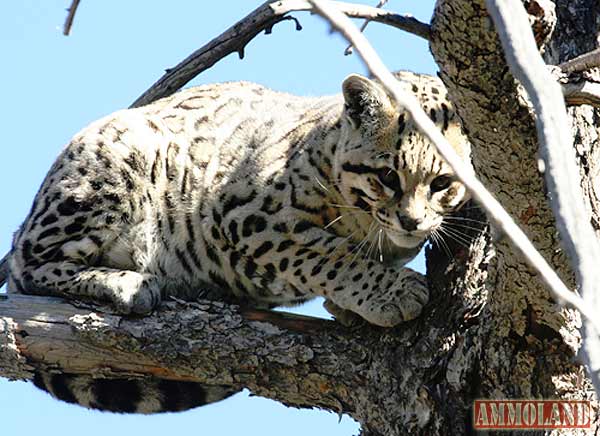Rare Ocelot Observed In Southern Arizona


PHOENIX, AZ – -(Ammoland.com)- Arizona Game and Fish Department officials report that a rare ocelot was observed this morning (Feb. 8) in the Huachuca Mountains in southern Arizona.
An individual called Game and Fish this morning to report that while he was working in his yard in the Huachuca Mountains, his dogs began barking at a cat-like animal which quickly climbed a tree. The individual drew closer and suspected that the small spotted cat might be an ocelot. An ocelot is a rare and endangered species of cat.
The man called Game and Fish and an officer responded to the site and confirmed that it was, in fact, an ocelot. The officer did a non-intrusive, visual inspection of the animal from the ground near the tree, and the animal appeared to be healthy. There was no indication that there had been any dog-to-cat direct interaction, as no wounds were visible on any animal.
As with all wildlife-human interaction cases, photos were taken of the animal. The officer was also able to retrieve some scat samples from the scene.
Once the final confirmation was determined, the officer directed that all humans and dogs retreat from the area, and the ocelot, apparently unharmed, was allowed to go on his way.
Ocelots are small to medium-sized spotted cats with a long tail. These cats have been listed as endangered since 1982 under the Federal Endangered Species Act. Since being listed, ocelots have only rarely been seen in Arizona. Only one other ocelot, an animal run over near Globe in April 2010, has been confirmed in Arizona since the mid 1960s. One other ocelot was reportedly captured on film by the Sky Island Alliance in November of 2009; however, it has not been possible to fully verify the species or the animal’s origin based on that photo.
Ocelots tend to be smaller in size in the more northerly portions of their habitat range than those individuals in the central or southern habitat areas. The upper body coloring is highly variable, ranging from grayish to cinnamon or tawny to reddish brown. Dark markings form chainlike streaks down the sides of the ocelot’s body. They have a long, curling, ringed tail that wraps around limbs for stability and is very indicative of the species.
The present range for ocelots is in the eastern and western lowlands of Mexico, from southern Mexico through Central America and in the lowland areas of Colombia, Ecuador, Peru and Brazil. On the fringes of their range, they occupy a very limited region in both the United States (a remnant population exists in Southern Texas) and Argentina. And now Arizona can be included in that range. Other animals such as bobcats and young mountain lions are sometimes misidentified as ocelots, which is why verification is so very important.
Arizona Game and Fish will work together with the U. S. Fish and Wildlife Service to review materials from the site and the photos to attempt to determine whether or not this was a naturally occurring ocelot. Some ocelots are known to be kept as pets, and occasionally, individual animals escape or are released into the wild.
Ocelots are protected by the Endangered Species Act and should be left alone. If anyone encounters a cat believed to be an ocelot, we would request that all sightings and photos along with observation information be reported immediately to the department. More information and additional photos will be made available Wednesday, visit www.azgfd.gov for details.
The Arizona Game and Fish Department prohibits discrimination on the basis of race, color, sex, national origin, age, or disability in its programs and activities. If anyone believes that they have been discriminated against in any of the AGFD’s programs or activities, including employment practices, they may file a complaint with the Deputy Director, 5000 W. Carefree Highway, Phoenix, AZ 85086-5000, (602) 942-3000, or with the Fish and Wildlife Service, 4040 N. Fairfax Dr. Ste. 130, Arlington, VA 22203. Persons with a disability may request a reasonable accommodation or this document in an alternative format by contacting the Deputy Director as listed above.
